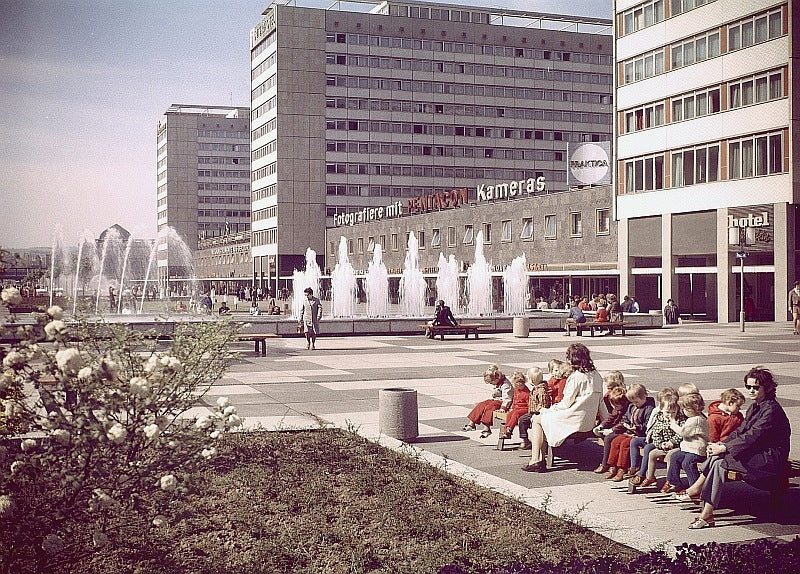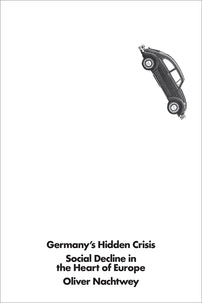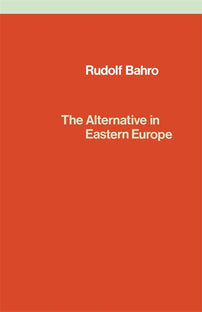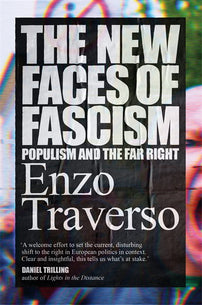Shades of Grey
The release of two recent books on the history of East Germany has reignited debates on the meaning of historical memory in Central Europe. Here, Lizzy Kinch asks what the controversy means about Germany's past and its political future.

Katja Hoyer’s history of the German Democratic Republic, Beyond the Wall: East Germany, 1949-1990, was published in March this year. Its aim, by drawing on interviews with ordinary people who lived and worked in the GDR, was to bring colour to the “caricature of the monochrome world of communism”. Hoyer’s GDR is not a joyless, repressive “Stasiland” but a society in which large parts of the non-political majority were content with the trade-off the state was offering: restrictions on personal liberty in return for stability, a relatively high standard of living, educational opportunities, secure employment, free childcare and affordable housing. The early reviewers of the book couldn’t agree on what the moral of the story was: Stuart Jeffries in the Guardian was tempted to read it as a “takedown of western hubris”[1] that highlighted social mobility and women’s rights in the East, while for Peter Hitchens in the Mail on Sunday, the takeaway point was that the GDR was a “grim … moral pigsty”[2]. But all were certain that Beyond the Wall is “essential reading”; an “extraordinary” book.
The German release followed two months later, and while the book was an immediate bestseller, particularly in the East, the critical reception was far more ambivalent. The historian Ilko-Sascha Kowalczuk accused Hoyer (allegedly across eight separate reviews, though I have only found four) of seeking to erase the memory of repression by failing to interview critics of the system. In Der Spiegel, the book was criticised as one-sided, offensive and fatally flawed by its “grotesque” reductiveness[3], while the review in Tageszeitung was almost an ad hominem attack. Hoyer’s parents, it claimed, were systemträger: people who were complicit in propping up the socialist system (her mother was a teacher and her father an officer in the East German army).[4] The implication was taken further by Norbert F. Pötzl in the Süddeutsche Zeitung. With striking condescension, he suggested that Hoyer – a research fellow in history at King’s College, London – holds an “astonishingly oblivious view of history”, having absorbed from an early age her parents’ rose-tinted stories of life in the GDR.
These negative reactions are partly the result of tensions between academic and popular history, and of the gulf between work done in universities and public conceptions of the past. Many of Hoyer’s critics take issue with the subtitle of the German edition: A New History of the GDR. Had Hoyer followed (their) scholarship over the past three decades, they argue, she would know there was nothing new in presenting the softer side of socialism. Reviews also highlighted factual errors (13 new districts were formed in 1952, not 14)[5]. But these professional frustrations can’t explain either the temperature of the debate or the widespread claims that Hoyer sought to whitewash the history of the GDR – a charge that is particularly unfair given some of the stories in the book: a teenage boy who bled to death after being shot trying to cross the Berlin Wall; her father’s arrest for telling jokes about the ruling Socialist Unity Party; individuals whose careers were blocked for ideological reasons.
* * *
Why is it, then, that so many German commentators feel the need to intervene when depictions of the GDR pick out lighter shades amid the grey? Perhaps some of the reason lies in the nature of German unification and what has happened since. It was not the unification of two states in the creation of a new Germany – with a new constitution, new symbols – that was the result of the fall of the Berlin Wall, but the absorption of East Germany into West.
Across all areas of state and society there was a reluctance to salvage anything of worth from the GDR, which many West Germans saw as a failed experiment. Reunification meant the rapid alignment of the GDR with the West’s market economy: regardless of their prosperity, the GDR’s 8,500 state-owned businesses were hastily privatised or closed down. Referred to as a “gold rush” (or “the greatest white-collar crime since the second world war”), 80% of these companies had been sold off cheaply to Westerners by 1994 and 14% to foreigners. Restitution laws also allowed Westerners to claim back property they had left behind in the East, leaving 2.2 million households at risk of dispossession. As the East German writer Ingo Schulz states: “There is no other region in Europe where the population owns so little of the land they live on, where so few can call property and businesses their own as in the East of Germany."[6]
[book-strip index="1"]
Privatisation went hand in hand with de-industrialisation and unemployment. Twenty months after reunification, 75% of employees at state-run enterprises in the East had lost their jobs and 4,000 companies had been closed down, while rapid deindustrialisation left up to 50% of 25-45 year-olds unemployed in some regions. Childcare in the GDR was practically free and ran from 6am to 6pm — East Germany had the highest rate of female employment in the world — but by 1991, half of nursery places for children under three had been scrapped. Those with qualifications were asked to retrain; many teachers had to return to university.
The West German historian Arnulf Baring summed up the dominant mood in 1991: “It makes no difference if they call themselves lawyers, economists, educationalists, psychologists, sociologists, even doctors or engineers,” he wrote. “Many have nothing to offer due to their lack of expertise. They simply haven't learned anything they could contribute to a free market society." These problems were not resolved as the 1990s wore on: by 2005, a fifth of all East Germans were unemployed[7]; permanent poverty (over a five-year period) is six times more common in the East than in the former West[8]; wages are still 22.5% lower.[9]
[book-strip index="2"]
The dispossession of Easterners has fuelled the rise of the far-right in the region, yet German media (staffed overwhelmingly by Westerners) often sidesteps structural analysis in favour of negative stereotypes about “Ossis”. Earlier this year, Dirk Oschmann, a literature professor at Leipzig University, published Der Osten: eine westdeutsche Erfindung (The East: a West German Invention), which has remained near the top of bestseller lists in Germany for the past few months. In it, Oschmann meticulously deconstructs the process of Othering — rooted in the anti-Slavic prejudices of 19th century German nationalism and redolent of the language used by colonialists condescending their subjects — that has led to the association of the East with “ugliness, stupidity, laziness, racism, chauvinism, right-wing extremism and poverty”. The West, conversely, remains cosmopolitan, liberal, democratic, diligent and educated. The lack of progress made since 1990 was illustrated with remarkable clarity shortly after the publication of Oschmann’s book. Matthias Döpfner, the CEO of Axel Springer, Europe’s biggest news publisher, was forced to apologise after text messages were leaked in which he described East Germans as “either communists or fascists, nothing in between … disgusting”.
* * *
Hoyer’s book has been so controversial partly because there are few mainstream avenues from which to challenge the totalising view of the GDR and the people from it. Drawing on Bourdieu, Oschmann shows that despite the ostensible equality of opportunity in contemporary Germany, those of Eastern origin lack the cultural, social and economic capital to succeed professionally. Easterners are only able to secure entry into the social elite after long stints in the West or abroad. Taking his cue from Annie Ernaux and Didier Eribon, he relates his own biography in detail – the son of workers in Thuringia, he spent years at universities in America before returning to a professorship.
In the 1990s Western academics came to dominate the humanities faculties of East German universities, bringing their doctoral students with them and displacing locals. Nowadays, as Oschmann highlights, there are still almost no professors from the East in university chairs of contemporary history, with obvious implications for national historiography. Political discourse is also dominated by voices from the West. In her sixteen-year chancellorship, Angel Merkel rarely risked association with the stigma of her eastern origins. Only at the end of her tenure did she voice frustration “as one of more than 16 million people who lived a life in the GDR who experience…judgement again and again… as if this life before German reunification didn’t really count… no matter what good and bad experiences one had.”[10]
[book-strip index="3"]
Class further compounds the inability to countenance “good” experiences in the East. As the German writer Marlen Hobrack contends, discourse surrounding the GDR is the result of a “radical fading out” of the class question. Public memory of the socialist state has been shaped by writers, intellectuals and artists who felt the brunt of censorship and lack of liberty. They struggle to imagine that people may have lived happy lives locked in behind the wall, aware of what they were missing on the other side, and deny the ability of the lower classes to testify their experiences. Yet for many ordinary people, abstract freedoms mattered little; they were happy with the security and sense of belonging that the GDR offered.
Hoyer gives some space to dissidents and apparatchiks, but it’s this silent, non-political majority that she centres: people like Christina Nagel, who at the age of 20, newly married and pregnant, was allocated a flat in a new block in Dresden in 1961. The family lived there for eight years; in an interview with Hoyer she said she had “never been happier in her life”. Living was communal: all the neighbours had young children who rode scooters up and down the corridors. Childcare was shared. By 1969, she had accumulated 500 hours of “building up” work (clearing rubble in Dresden, for example) alongside regular contributions to a housing fund, so the family were offered a flat twice the size. “I thought I was dreaming!” she told Hoyer. Another is Karin Tobianke, the daughter of a quarryman who grew up on a farm in Saxony. Though not the top of her class, in 1965 she was nominated by her teacher to attend the extended secondary school to study for university. She received a government grant, went on trips to Moscow and ultimately became a history and Russian teacher – a career she owed to deliberate state intervention that aimed to encourage women’s equal participation in society. It is in documenting and recounting these positive experiences that Hoyer has fallen foul of the absolutist view of the history of the GDR.
* * *
All this matters in the present day because those in the political mainstream who deride “Ossis” — and lament the rise of the far-right in the East — often do so by blaming the GDR. In the 2021 federal elections, the anti-immigration Alternative für Deutschland was the leading party in Saxony and Thuringia (24.6% and 24% vote-share respectively) and this June they won their first district council election in Sonneberg (with 52.8% of the vote). Yet instead of looking to socio-economic developments in the East since 1990, Marco Wanderwitz, the government’s special commissioner for East Germany, explained two years ago: “We are dealing with people who are partially socialised by dictatorship in such a way that they have not reached democracy, even after 30 years.” The socialist state simply didn’t teach its citizens to respect other people, Armin Laschet, former leader of the conservative Christian Democrat Party, suggested in 2016.
This missing of the point is strikingly shortsighted — forgetting both that East Germans cared enough about democracy to bring down the Berlin Wall and the popularity of the AfD amongst voters not yet alive when it fell. But more dangerously, as Oschmann argues, by constantly dismissing Easterners, these voices increase the likelihood of more voters turning to populist parties that play upon a sense of exclusion, disaffection and victimhood. In projecting all that is bad onto the GDR (racism, the AfD) while parallels in the West (Nazis in the Federal Republic, neo-Nazis today) are sidestepped, Germany finds itself with an alarmingly split psychology. It can only heal its divisions by placing a new, balanced, nuanced version of GDR history at the centre of its popular imagination. Thirty years after the wall fell, the success of Hoyer and Oschmann’s books suggest that a new generation is keen to do so.
Lizzy Kinch lives in London, where she works in history documentaries and translates German fiction.
[book-strip index="4"]
[6] Oschmann, p.140.
[7] Hoyer
[8] Steffen Mau, Lütten Klein, p. 163, quoted in Oschmann.
[9] Oschmann, p.135.
[10] Hoyer



